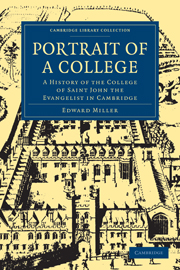I - BEGINNINGS (1511–1537)
Published online by Cambridge University Press: 07 September 2010
Summary
Four hundred and fifty years ago, on 9 April 1511, the executors of the Lady Margaret Beaufort appended their seals to formal letters which announced the birth of a new college in the University of Cambridge. In Thomas Baker's summary, those letters set forth the ‘desolate state’ of the old Hospital of St John, ‘the intention of the foundress for dissolving [that] house and annexing it to the college to be erected’, and the various licences obtained to this end. In virtue of these licences the executors ‘did thereby erect, ordain and establish a perpetual college’ to consist of a master, fellows and scholars to the number of fifty or thereabouts in scientiis liberalibus et sacra theologia studentium et oraturorum. It was to be called St John's College, to be a corporate body with a common seal and to be empowered to purchase and receive lands for its upkeep. Robert Shorton was designated first master and three nominees of the bishop of Ely were ‘taken and elected … to be fellows and scholars’. The executors retained power to nominate further fellows and, ‘if that number were not completed during their lives, the master and fellows … might fill up that number’. Finally, the master's authority to govern fellows and scholars was made plain, although in certain matters he was to be under an obligation to call together all the fellows in order to obtain their consent to action he proposed.
- Type
- Chapter
- Information
- Portrait of a CollegeA History of the College of Saint John the Evangelist in Cambridge, pp. 1 - 15Publisher: Cambridge University PressPrint publication year: 2009First published in: 1961

